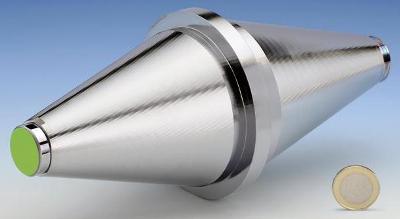Researchers from the Physikalisch-Technische Bundesanstalt (PTB) and the American NIST (National Institute of Standards and Technology)/JILA have developed and tested the world’s most stable laser. The result of this research cooperation, performed within the range of the Excellence Cluster QUEST, revealed an unequalled laser with stable frequency.
 The size of the new silicon resonator compared to the size of a coin
The size of the new silicon resonator compared to the size of a coin
The research work, reported in the journal “Nature Photonics”, is significant for optical spectroscopy with high resolution. Now, a more stable interrogation laser is available for optical atomic clocks.
Modern optical atomic clocks need laser sources that have the capacity to radiate light with stable frequency. Without additional measures, commercial laser systems are not suitable for this purpose. But, this can be realized by stabilizing them with the help of optical resonators, which are composed of two reflecting mirrors placed at a fixed distance through a spacer. The crucial aspect is that in parallel to an organ pipe, the length of a resonator defines the frequency through which light oscillates in the resonator, and therefore, resonators having high length stability are needed for stable lasers.
Modern laser systems stabilized with a resonator have been developed to an extent that their steadiness is limited by the resonators’ thermal noise. The atoms present in the resonator, like the Brownian motion of molecules, are constantly moving and binding its length stability. Until now, resonators have been composed of glass. But the research group utilized single-crystal silicon in order to create the new resonator. Silicon, cooled down at 124 K, is distinguished by a small thermal expansion. The researchers used a fitting low-vibration cryostat in order to operate the resonator at the 124 K temperature. Through this method, the scientists demonstrated a 1 • 10-16 frequency stability for the laser equalized to the silicon resonator. This enables them to develop better optical atomic clocks.